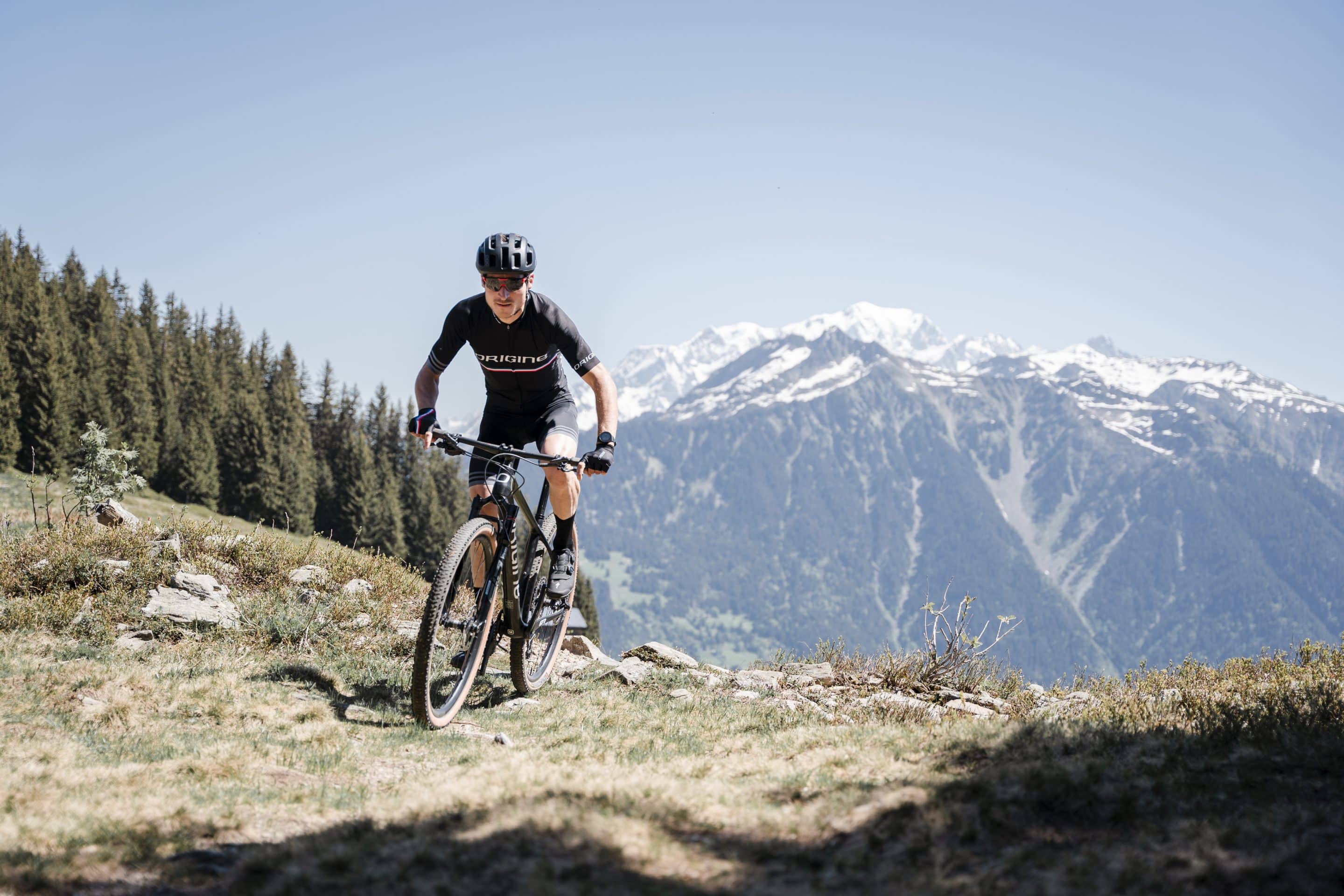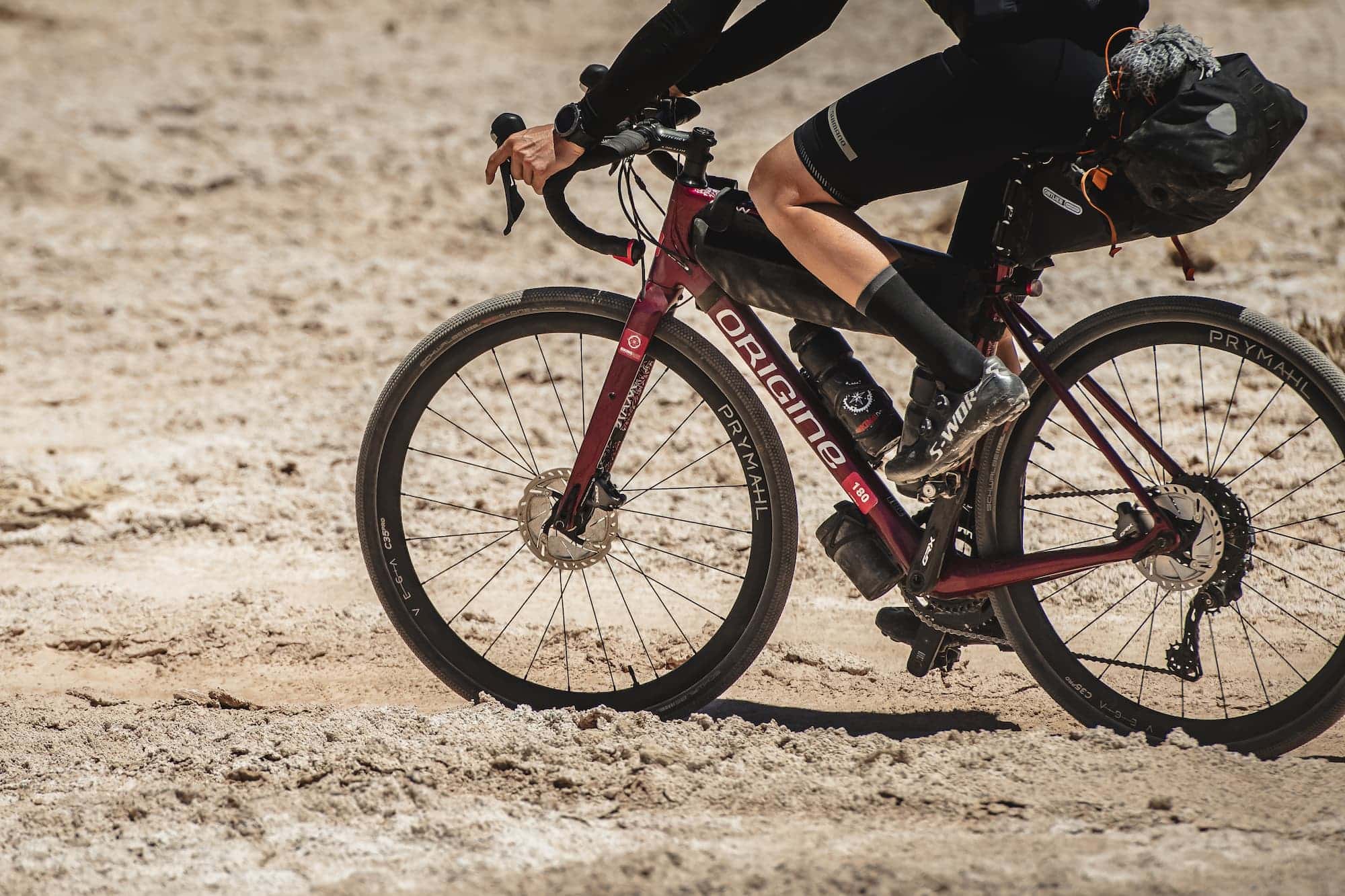What are the advantages and disadvantages of each type of bike? What criteria should you consider to make the right choice? Explore our guide to help you decide between a Mountain Bike and a Gravel Bike.
Gravel ou VTT, deux philosophies différentes
Le VTT a connu un essor, en France, dans les années 1990 grâce aux nouvelles possibilités qu’il offrait aux cyclistes. Enfin, un vélo pouvait passer sur les chemins, les sentiers, et sortir des sentiers battus à travers les sous-bois. Le tout-terrain a cette vocation de s’épanouir en “off-road”, c’est-à-dire en dehors des routes asphaltées. Le Mountain Bike s’est ensuite spécialisé selon des disciplines plus ou moins engagées : Cross-country, Trail, All-moutain, Enduro, DH. Pour ce comparatif avec les vélos gravel, nous ne retiendrons que les VTT Cross-country (XC). Ce sont des vélos à cintre plat, dotés d’une fourche avec suspension, capables d’accepter des sections de pneus larges de 2,25″ (57mm), monoplateau et avec des dentures de cassettes jusqu’à 10-52.
Gravel Bikes: A Newer Trend
Gravel biking has seen much more recent growth. Emerging in the United States in the 2010s, this type of bike has gained popularity in France since 2016. The term “gravel,” meaning “gravel” in English, refers to a bike designed for both road and off-road use. Gravel biking is closely associated with the concept of bikepacking. Unlike cyclocross bikes, which are built for competition, gravel bikes are designed for adventure and long-distance riding.
Gravel bikes are ideal for day trips, weekend getaways, or even week-long cycling adventures with bikepacking bags. With a geometry similar to a road bike, gravel bikes feature drop handlebars and can accommodate tire widths of up to 45mm. These bikes lack suspension and can be equipped with either single or double chainrings, making them versatile and practical for various terrains and distances.
Gravel Frame vs. Mountain Bike Frame: What Are the Differences?
Gravel Frame
Gravel bike frames are designed with endurance in mind. The geometry is much less aggressive than that of a road bike (or a cyclocross bike), allowing riders to spend long hours on the bike without experiencing neck or back pain. Compared to road bikes, gravel frames have a more upright handlebar position for better comfort. They also feature longer chainstays and wheelbases, enhancing stability. Additionally, gravel frames are designed to accommodate wider tires, up to 45mm, for improved versatility on mixed terrain.
Mountain Bike Frame
Mountain bike frames are designed with a forward-leaning geometry. This shifts the rider’s weight toward the fork and suspension, enabling more aggressive and sporty handling. The position prioritizes control and maneuverability, ideal for tackling technical terrain and descents, but it sacrifices some comfort for extended periods in the saddle. Mountain bike frames are also built to handle wider tires and are often paired with suspension systems to absorb shocks and impacts on rough trails.

Gravel Tires vs. Mountain Bike Tires
Gravel Tires
Gravel tires come in a wide variety to suit different riding styles, ranging from slick tires for long-distance rides primarily on paved roads to 650B tires designed for rough gravel paths. Gravel tire widths typically range between 32mm and 45mm (up to 47mm with 650B wheels). Most gravel tires are tubeless, offering reduced rolling resistance and better puncture resistance. They feature smaller knobs compared to mountain bike tires, maintaining good performance on asphalt while providing adequate grip on mixed terrain.
Mountain Bike Tires
Mountain bike tires are wider, with typical widths between 2″ and 2.25″. The additional volume allows for low-pressure riding, which improves shock absorption and comfort on rough terrain. MTB tires have much larger and more aggressive knobs for better traction on trails and in muddy conditions. They are also tubeless, with reinforced casings to resist cuts from rocks and other debris. However, these tires are heavier and less efficient on paved roads due to their design and increased rolling resistance.
Mountain Bike with Suspension vs. Gravel Bike without Suspension
Mountain Bike with Suspension
Hardtail mountain bikes are equipped with a front suspension fork offering travel between 100mm and 120mm. This suspension effectively absorbs shocks and irregularities on trails, providing excellent comfort, especially on rough terrain. However, the suspension adds extra weight compared to the rigid fork of a gravel bike. At equivalent price points, a mountain bike typically weighs about 1 kg more than a gravel bike.
Gravel Bike without Suspension
Gravel bikes do not have suspension in the fork, which helps keep the overall weight of the bike low but limits comfort. Instead, comfort and shock absorption rely on the tires and the frame. To compensate for the lack of suspension, careful selection of the saddle and handlebar tape—key contact points between the rider and the bike—is essential to minimize discomfort and absorb vibrations effectively.

Flat Handlebar on Mountain Bikes vs. Dropbar on Gravel Bikes
Mountain Bikes (Flat Handlebar)
Mountain bikes are equipped with flat and wide handlebars. This design enhances stability on challenging terrain and provides greater precision when selecting lines or navigating obstacles. However, this setup is less aerodynamic and exposes the rider to more wind resistance, which can be a disadvantage on open or flat sections.
Gravel Bikes (Dropbar)
Gravel bikes feature drop handlebars, similar to those found on road bikes. These narrower handlebars allow the rider to switch between three different hand positions: on top of the bars, on the brake/shift levers, or in the drops. This variability helps riders adjust their posture based on fatigue levels and terrain, offering a balance between comfort, aerodynamics, and control.
Transmission and Gear Ratios: Gravel vs. Mountain Bikes
Mountain Bike Transmission
Mountain bikes exclusively use single-chainring (1x) transmissions. Chainring sizes typically range from 30 to 36 teeth. Paired with wide-range cassettes, such as 10-52, this setup provides a broad range of gear ratios, ideal for tackling steep climbs, technical descents, and varying speeds. While the gear spacing is less tight (larger jumps between gears), this configuration excels in versatility for diverse terrains.
Gravel Bike Transmission
Gravel bike transmissions, inspired by mountain biking, often use a single chainring (1x) setup with chainring sizes between 36 and 42 teeth. However, gravel bikes also offer the flexibility of double chainring (2x) groupsets for riders seeking finer gear steps. For instance, Shimano’s GRX groupsets are available in configurations like 46/30 or 48/31, paired with road cassettes (e.g., 11-34) or mountain bike cassettes (e.g., 11-42).
Technologies such as rear derailleur chain stabilization systems (e.g., Shimano’s Shadow+) and chainring designs with narrow-wide teeth profiles (e.g., Wolf Tooth) originated from mountain bike R&D and have been adapted for gravel bikes. These innovations improve chain retention and shifting reliability, essential for mixed-terrain riding.


![[Guide] How to Get Started in Ultra-Cycling ?](https://cyclisthouse.origine-cycles.com/wp-content/uploads/2021/12/BikingMan-x-Origine-Cycles-1_adobespark-400x250.jpeg)
